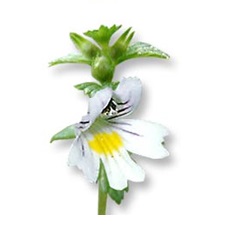
Medicine:
Use: Used for swelling (inflammation) of the nasal cavity and sinuses (rhinosinusitis), allergies, hay fever, and many other conditions
Euphrasia rostkoviana common names Eyebright, Eyewort, is a plant from the genus Euphrasia, in the family Orobanchaceae. Native to Europe, Eyebright has small, scallop-edged white flowers with yellow spots and purple streaks, somewhat resembling a bloodshot human eye. Historically, Eyebright's use for eye problems was due to the Doctrine of Signatures, a sixteenth-century theory that held that a plant's appearance indicated the conditions it could treat.
Eyebright has been used in the traditional Austrian medicine internally as tea, or externally as compresses, for treatment of disorders of the eyes like redness and irritation and the gastrointestinal tract. The parts that grow above the ground are used to make medicine.
Eyebright contains; tannins, resins, volatile oil, mannite, iridoid glycosides, the favonoids rutin and quercetin, saponins, essential fatty acids, sterols, iron, silicon, traces of iodine, copper, and zinc; vitamins A, C, D, E and B complex.
Eyebright has been traditionally used to treat all manner of eye maladies including; inflammation, conjunctivitis, red-eye, styes, itchy eyes, stinging eyes and weak vision.
Eyebright is taken by mouth for swelling (inflammation) of the nasal cavity and sinuses (rhinosinusitis), allergies, hay fever, and many other conditions, but there is no good scientific evidence to support these uses. Despite serious risk of infection, some people apply eyebright directly to the eye for conjunctivitis, eyelid swelling (blepharitis), and eye fatigue. The chemicals in eyebright might act as astringents and kill bacteria.